Development of a Tool to Support the Sustainable Management of Urban Living Labs as Platforms for Co-Creation †
Abstract
1. Introduction
2. Theoretical Background and Related Works
2.1. Living Labs for Social Transformation
2.2. Platform-Level Living Labs
2.3. Tools to Support Living Lab Practices
2.4. Research Gap
3. Method
3.1. Setting the Scope
3.2. Approach
3.3. Case Selection and Data Collection
3.4. Data Analysis
4. Results
4.1. Key Elements for the Sustainable Management of Platform-Level Living Labs
4.2. Development of the Platform-Level Living Lab Canvas
4.3. Step-by-Step Process to Describe the Canvas
4.3.1. Step 1: Answer the Question List
4.3.2. Step 2: Map to the Canvas
4.3.3. Step 3: Review the Canvas
4.3.4. After Filling in the First Canvas: Update the Contents of the Canvas
5. Case Application
5.1. Overview
5.2. Example Cases
5.2.1. Case A: Min-Sta Living Lab
5.2.2. Case B: A ULL in a Long-Term R&D Project
5.3. Application Results
5.4. Findings
5.4.1. Findings for Question (1)
5.4.2. Findings for Question (2)
6. Discussion
6.1. Theoretical Contributions
6.2. Practical Contributions
6.3. Limitations
6.4. Towards the Management of the Long-Term Operation of Platform-Level Living Labs
7. Conclusions and Outlook
Author Contributions
Funding
Institutional Review Board Statement
Informed Consent Statement
Data Availability Statement
Acknowledgments
Conflicts of Interest
Abbreviations
| ULL | Urban living lab |
| ENoLL | European Network of Living Labs |
| PFLL canvas | Platform-level living lab canvas |
| PF | Platform |
Appendix A
| # | Corresponding Elements | Questions |
|---|---|---|
| 1 | Organising team | What members (individuals and organisations) are included in the team operating and managing the platform-level living lab (i.e., the platform-level living lab organising team)? Please list all members. Only include members who are involved in the management side of the platform-level living lab. Individuals and organisations that are only involved in individual projects within the platform-level living lab are out of scope. |
| 2 | Platform owner | Who is the ‘platform owner’ (i.e., the individual or organisation in charge of the management and operation of the platform-level living lab) in the platform-level living lab organising team? |
| 3 | Features of the platform owner | What are the features of the platform owner? Features refer to those related to the platform owner’s past initiatives, technology/products/services owned, business, and positioning, etc. |
| 4 | Field | What is the region or city where the platform-level living lab is (or will be) operated (hereafter, PF-LL Field)? Please provide the name of the region/city. |
| 5 | Features of the field | What are the features of the platform-level living lab field? Features refer to those of the region or city (e.g., culture, industry, geographical conditions, local issues to be addressed), not those of the living lab initiatives. |
| 6 | Local actors | In the platform-level living lab field, what local actors (individuals, local firms, shops, organisations, communities, etc.) are directly or indirectly involved in platform-level living lab initiatives? Please consider local actors that cooperate with the various projects carried out within the platform-level living lab rather than actors involved in the platform organising teams. |
| 7 | Projects | What projects have you implemented or do you plan to implement within the platform-level living lab? Please list three or fewer of your main projects. |
| 8 | Space/facility | What physical spaces (places), facilities, and equipment can be used in projects in the platform-level living lab? Please list, for example, spaces for holding workshops and events, facilities for developing and testing the products/service, and the equipment related to these. |
| 9 | Community | What citizen communities continuously cooperate with platform-level living lab initiatives? Include both newly developed communities and existing communities that cooperate with living lab activities. |
| 10 | Community development activity | What activities are conducted to build or expand new citizen communities that continuously cooperate with the platform-level living lab initiatives? Alternatively, what activities are conducted to strengthen the relationship with the existing citizen communities? |
| 11 | Partnership development activity | What activities are conducted to build or expand new networks (relationships) with organisations, such as firms and research institutes that continuously cooperate with the platform-level living lab initiatives? Alternatively, what activities are conducted to strengthen the relationship with organisations that have cooperative relationships? |
| 12 | Orchestrator | Does your platform-level living lab have a person in charge of coordinating and managing co-creation activities for innovation (i.e., an orchestrator)? If so, please provide information about the orchestrator. |
| 13 | Operational cost | What financial costs are regularly incurred in the platform-level living lab operation? |
| 14 | Revenue/budget | What budgets can be used to operate the platform-level living lab? This includes revenues in platform-level living lab activities, external grants, subsidies, etc. |
| 15 | Visions/goals of the platform | What goals or visions does the platform-level living lab organising team aim to achieve? Please describe the goals or visions regarding the overall platform-level living lab initiative rather than those regarding individual projects promoted within the platform-level living lab. |
| 16 | Visions/goals of the field | What goals or visions does the platform-level living lab field (i.e., region or city) aim to achieve? Please describe the goals or visions regarding the overall platform-level living lab initiative rather than those regarding individual projects promoted within the platform-level living lab. |
| 17 | Values for the platform | What values (benefits, advantages) can the platform-level living lab organising team obtain by continuously operating the platform-level living lab? Please consider the values that can be obtained through the overall platform-level living lab initiative from a long-term perspective rather than those obtained through individual projects promoted within the platform-level living lab. |
| 18 | Monitoring (Platform) | What monitoring items for value can the platform-level living lab organising team obtain? |
| 19 | Values for the field | What values (benefits, advantages) can the platform-level living lab field (region or city) obtain by continuously operating the platform-level living lab? Please consider the values that can be obtained through the overall platform-level living lab initiative from a long-term perspective rather than those obtained through individual projects promoted within the platform-level living lab. |
| 20 | Monitoring (Field) | What monitoring items for value can the platform-level living lab field obtain? |
References
- Hossain, M.; Leminen, S.; Westerlund, M. A systematic review of living lab literature. J. Clean. Prod. 2019, 213, 976–988. [Google Scholar] [CrossRef]
- Leminen, S.; Rajahonka, M.; Westerlund, M.; Hossain, M. Collaborative innovation for sustainability in Nordic cities. J. Clean. Prod. 2021, 328, 129549. [Google Scholar] [CrossRef]
- Voytenko, Y.; McCormick, K.; Evans, J.; Schliwa, G. Urban living labs for sustainability and low carbon cities in Europe: Towards a research agenda. J. Clean. Prod. 2016, 123, 45–54. [Google Scholar] [CrossRef]
- Rittel, H.W.J.; Webber, M.M. Dilemmas in a general theory of planning. Policy Sci. 1973, 4, 155–169. [Google Scholar] [CrossRef]
- Chronéer, D.; Ståhlbröst, A.; Habibipour, A. Urban living labs: Towards an integrated understanding of their key components. Echnology Innov. Manag. Rev. 2019, 9, 50–62. [Google Scholar] [CrossRef]
- Europe, J.U. Urban Europe: Creating Attractive, Sustainable and Economically Viable Urban Areas. Joint Call for Proposals 2013; JPI Urban Europe: Vienna, Austria, 2013. [Google Scholar]
- Patton, M.Q. Qualitative Research and Evaluation Methods, 3rd ed.; Sage Publications: Thousand Oaks, CA, USA, 2002. [Google Scholar]
- Engez, A.; Leminen, S.; Aarikka-Stenroos, L. Urban living lab as a circular economy ecosystem: Advancing environmental sustainability through economic value, material, and knowledge flows. Sustainability 2021, 13, 2811. [Google Scholar] [CrossRef]
- Ersoy, A.; Van Bueren, E.V. Challenges of urban living labs towards the future of local innovation. Urban Plan. 2020, 5, 89–100. [Google Scholar] [CrossRef]
- Gualandi, E.; Romme, A.G.L. How to make living labs more financially sustainable? Case studies in Italy and the Netherlands. Eng. Manag. Res. 2019, 8, 11–19. [Google Scholar] [CrossRef]
- Mastelic, J.; Sahakian, M.; Bonazzi, R. How to keep a living lab alive? Info 2015, 17, 12–25. [Google Scholar] [CrossRef]
- Santonen, T.; Julin, M. Empirical evaluation of health and wellbeing living lab business models. In Proceedings of the 2019 ISPIM Conference, Florence, Italy, 16–19 June 2019. [Google Scholar]
- Santonen, T.; Julin, M.; Salmi, A.; Leskinen, J. Understanding the underlying factors of living lab business model. In Proceedings of the 2020 ISPIM Conference, Osaka, Japan, 7–8 December 2020. [Google Scholar]
- Veeckman, K.; Schuurman, D.; Leminen, S.; Lievens, B.; Westerlund, M. Linking characteristics and their outcomes in living labs: A Flemish-Finnish case study. In Proceedings of the 2013 ISPIM Conference, Helsinki, Finland, 16–19 June 2013. [Google Scholar]
- Schuurman, D.; Herregodts, A.L.; Georges, A.; Rits, O. Innovation management in Living Lab projects: The innovatrix framework. Technol. Innov. Manag. Rev. 2019, 9, 63–73. [Google Scholar] [CrossRef]
- Verhoef, L.; Bossert, M. The University Campus as a Living Lab for Sustainability—A Practitioner’s Guide and Handbook; AMS Institute: Delft, The Netherlands, 2019. [Google Scholar]
- Zimmermann, F.; Ponomareva, A.; Spagnoli, F.; White, M.D.L.R. Capacity Building Handbook and Mentoring Report, 2023. Available online: https://openlab-project.eu/app/uploads/D1-4_Capacity-Building-Handbook-Mentoring-report-89.pdf (accessed on 17 March 2025).
- Yasuoka, M. How to transfer tacit knowledge for Living Lab practice consideration on tacit knowledge representations. In Proceedings of the Annual Hawaii International Conference on System Sciences, Maui, HI, USA, 5–8 January 2021. [Google Scholar] [CrossRef]
- ENoll. ENoLL Member Catalogue, n.d. Available online: https://enoll.org/publication/enoll-member-catalogue-2024/ (accessed on 17 March 2025).
- Abi Saad, E.; Agogué, M. Living Labs in science-industry collaborations: Roles, design, and application patterns. Technovation 2024, 135, 103066. [Google Scholar] [CrossRef]
- Joore, P.; Brezet, H. A Multilevel Design Model: The mutual relationship between product-service system development and societal change processes. J. Clean. Prod. 2015, 97, 92–105. [Google Scholar] [CrossRef]
- Akiyama, H. Aging well: An update. Nutr. Rev. 2020, 78 (Suppl. 2), 3–9. [Google Scholar] [CrossRef] [PubMed]
- Sakakura, K. Co-creating a Living Lab for sustainable community engagement. In Proceedings of the Digital Living Lab Days Conference 2021, Online, 6–10 September 2021. [Google Scholar]
- Schuurman, D. Bridging the Gap Between Open and User Innovation?: Exploring the Value of Living Labs as a Means to Structure User Contribution and Manage Distributed Innovation. Ph.D. Thesis, Ghent University, Gent, Belgium, 2015. [Google Scholar]
- Evans, P.; Schuurman, D.; Ståhlbröst, A.; Vervoort, K. U4IoT Living Lab Methodology Handbook. 2017. Available online: https://issuu.com/enoll/docs/366265932-u4iot-livinglabmethodology-handbook (accessed on 17 March 2025).
- Habibipour, A.; Ståhlbröst, A.; Zalokar, S.; Vaittinen, I. Living Lab Handbook for Urban Living Labs Developing Nature-Based Solutions. 2020. Available online: https://issuu.com/enoll/docs/ull_handbook_online_version (accessed on 17 March 2025).
- Ståhlbröst, A.; Holst, M. The Living Lab Methodology Handbook; VINNOVA: Stockholm, Sweden, 2012.
- UNaLAB. Toolkit for Co-Creation, n.d. Available online: https://unalab.enoll.org/ (accessed on 17 March 2025).
- Vaittinen, I. Guidelines for Developing & Implementing Living Labs for Climate Services in Urban Planning, n.d. Available online: https://enoll.org/2018/07/17/guidelines-for-living-labs-in-climate-services/ (accessed on 17 March 2025).
- SISCODE. SISCODE Toolbox for Co-Creation Journeys, n.d. Available online: https://siscodeproject.eu/wp-content/uploads/2019/09/toolkit-27092019-1.pdf (accessed on 17 March 2025).
- Akasaka, F.; Mitake, Y.; Watanabe, K.; Tsutsui, Y.; Shimomura, Y. Development of a self-assessment tool for the effective management of Living Labs. J. Eng. Technol. Manag. 2023, 70, 101783. [Google Scholar] [CrossRef]
- D’Hauwers, R.; Rits, O.; Schuurman, D. A hypothesis driven tool to structurally embed user and business model research within Living Lab innovation tracks. In Proceedings of the Open Living Lab Days Conference, Istanbul, Turkey, 25–28 August 2015. [Google Scholar]
- Smeenk, W. The empathic Co-Design Canvas: A tool for supporting multi-stakeholder co-design processes. Int. J. Des. 2023, 17, 81–98. [Google Scholar]
- Höök, K.; Löwgren, J. Strong concepts: Intermediate-level knowledge in interaction design research. ACM Trans. Comput. Hum. Interact. 2012, 19, 23. [Google Scholar] [CrossRef]
- Colusso, L.; Bennett, C.L.; Hsieh, G.; Munson, S.A. Translational resources: Reducing the gap between academic research and HCI practice. In Proceedings of the 2017 Conference on Designing Interactive Systems (DIS ’17), Edinburgh, UK, 10–14 June 2017; ACM: New York, NY, USA, 2017; pp. 957–968. [Google Scholar] [CrossRef]
- Japan Cabinet. Secretariat. Dijiden, n.d. Available online: https://www.cas.go.jp/jp/seisaku/digitaldenen/en/index.html (accessed on 17 March 2025).
- Steen, K.; Bueren, V.E. The defining characteristics of urban living labs. Technol. Innov. Manag. Rev. 2017, 7, 7. [Google Scholar] [CrossRef]
- Merriam, S.B. Qualitative Research and Case Study Applications in Education; Jossey-Bass: San Francisco, CA, USA, 1998. [Google Scholar]
- Yazan, B. Three approaches to case study methods in education: Yin, Merriam, and Stake. Qual. Rep. 2015, 20, 134–152. [Google Scholar] [CrossRef]
- Palinkas, L.A.; Horwitz, S.M.; Green, C.A.; Wisdom, J.P.; Duan, N.; Hoagwood, K. Purposeful sampling for qualitative data collection and analysis in mixed method implementation research. Admin. Policy Ment. Health 2015, 42, 533–544. [Google Scholar] [CrossRef]
- Barriball, K.L.; While, A. Collecting data using a semi-structured interview: A discussion paper. J. Adv. Nurs. 1994, 19, 328–335. [Google Scholar] [CrossRef]
- Kuckartz, U. Qualitative Text Analysis: A Guide to Methods, Practice and Using Software; Sage Publications: Thousand Oaks, CA, USA, 2014. [Google Scholar] [CrossRef]
- Rädiker, S.; Kuckartz, U. Focused Analysis of Qualitative Interviews with MAXQDA.; MAXQDA Press: Berlin, Germany, 2020. [Google Scholar]
- Adams, R.; Bessant, J.; Phelps, R. Innovation management measurement: A review. Int. J. Manag. Rev. 2006, 8, 21–47. [Google Scholar] [CrossRef]
- Osterwalder, A.; Pigneur, Y. Business Model Generation: A Handbook for Visionaries, Game Changers, and Challengers; John Wiley & Sons: Hoboken, NJ, USA, 2010. [Google Scholar]
- Akasaka, F.; Mitake, Y.; Oura, F.; Watanabe, K.; Kojima, K. Infrastructuring social labs: Establishing a sustainable research, development, and innovation platform driven by citizen collaboration. In Proceedings of the Open Living Lab Days Conference, Barcelona, Spain, 21–23 September 2023; pp. 118–133. [Google Scholar]
- Favaloro, T.; Ball, T.; Lipschutz, R.D. Mind the gap! Developing the campus as a living lab for student experiential learning in sustainability. In Sustainability on University Campuses: Learning, Skills Building and Best Practices.; World Sustainability Series; Leal Filho, W., Bardi, U., Eds.; Springer: Cham, Switzerland, 2019; pp. 91–113. [Google Scholar] [CrossRef]
- Mazutti, J.; Londero Brandli, L.; Lange Salvia, A.; Fritzen Gomes, B.M.; Damke, L.I.; Tibola da Rocha, V.; Santos Rabello, R.D. Smart and learning campus as living lab to foster education for sustainable development: An experience with air quality monitoring. Int. J. Sustain. High. Educ. 2020, 21, 1311–1330. [Google Scholar] [CrossRef]
- Logghe, S.; Schuurman, D. Action research as a framework to evaluate the operations of a living lab. Technol. Innov. Manag. Rev. 2017, 7, 35–41. [Google Scholar] [CrossRef]
- Yusubova, A.; Andries, P.; Clarysse, B. The role of incubators in overcoming technology ventures’ resource gaps at different development stages. RD Manag. 2019, 49, 803–818. [Google Scholar] [CrossRef]
- Hillgren, P.; Seravalli, A.; Emilson, A. Prototyping and infrastructuring in design for social innovation. CoDesign 2011, 7, 169–183. [Google Scholar] [CrossRef]
- Akasaka, F.; Akiyama, H.; Yasuoka, M.; Nakatani, M.; Nambu, R. Platform-level Living Lab Canvas: A tool to support the sustainable management of living labs for social transformation. In Proceedings of the Open Living Lab Days Conference, Timisoara, Romania, 24–27 September 2024; pp. 36–49. [Google Scholar]
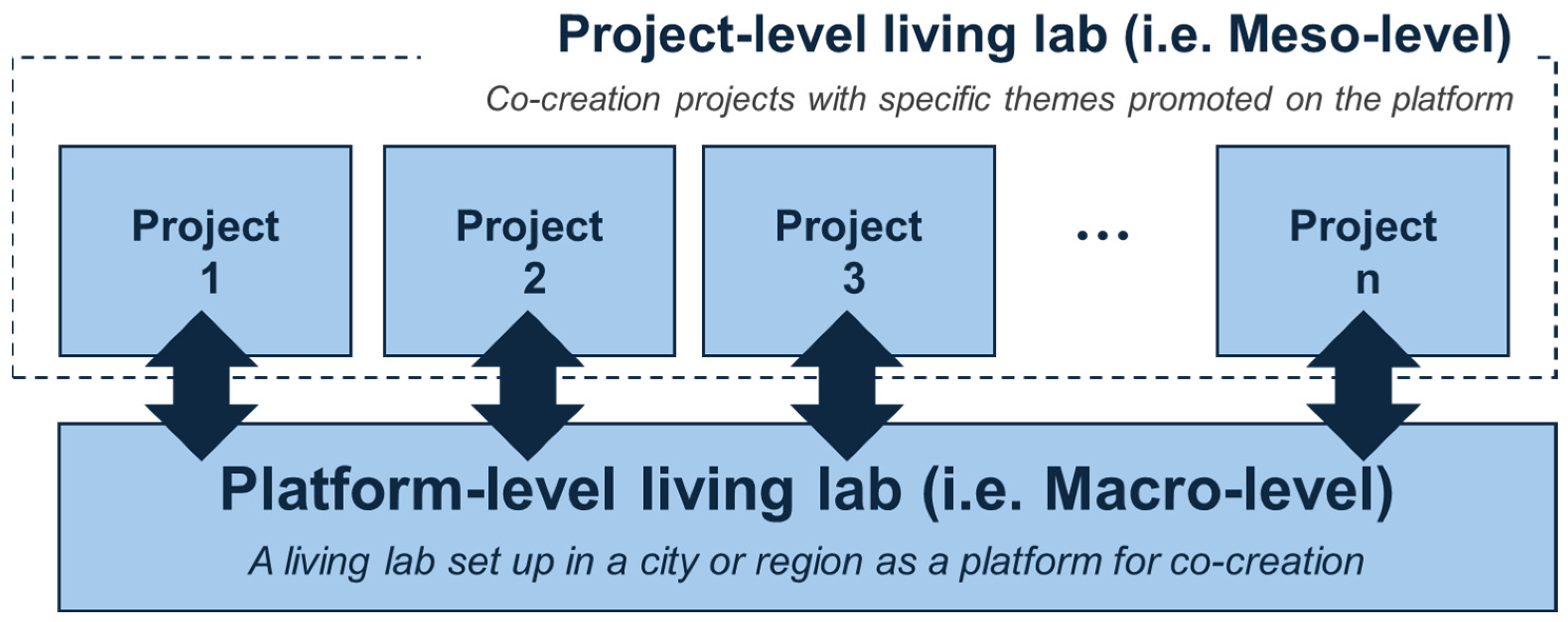

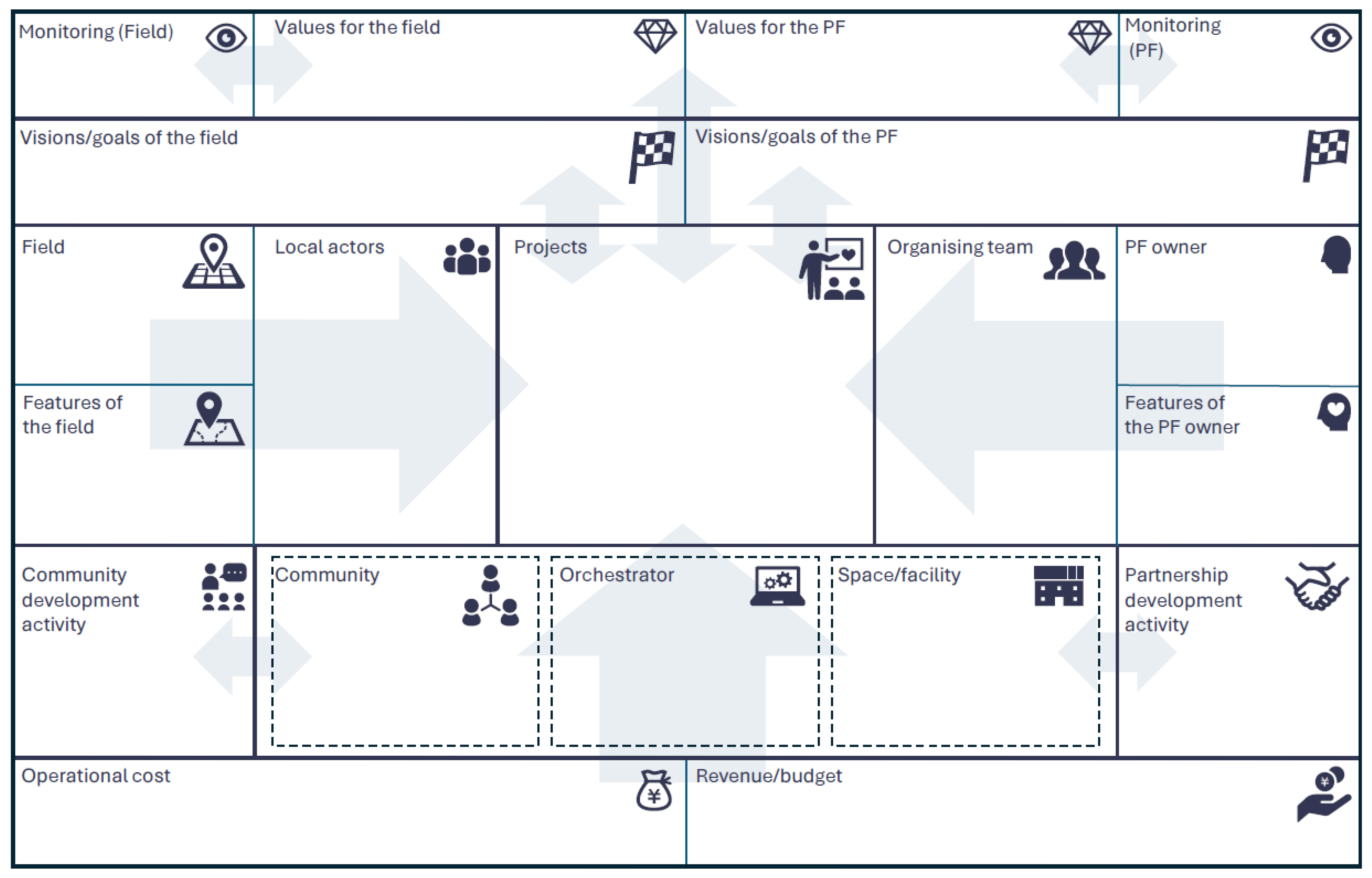
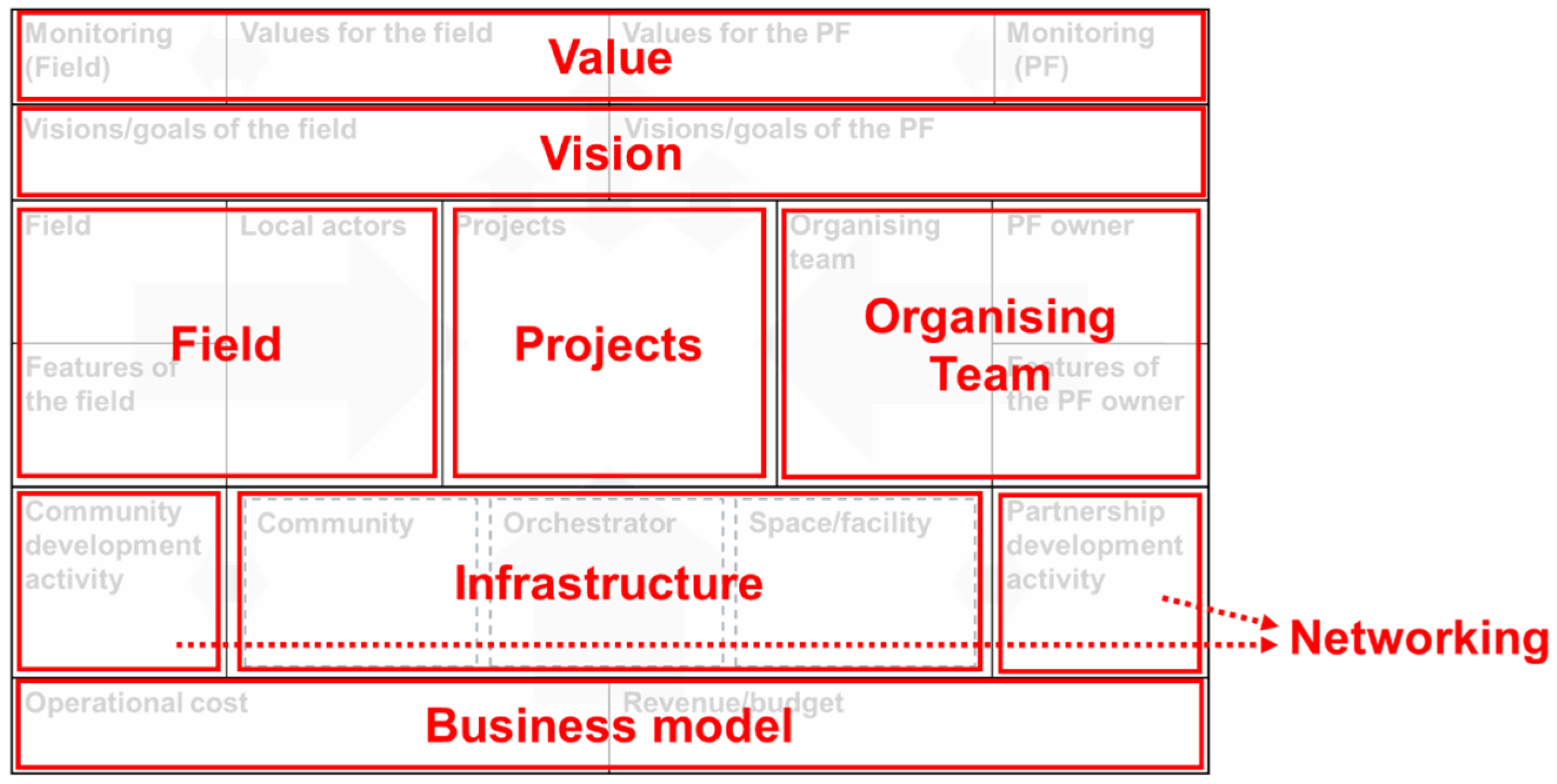
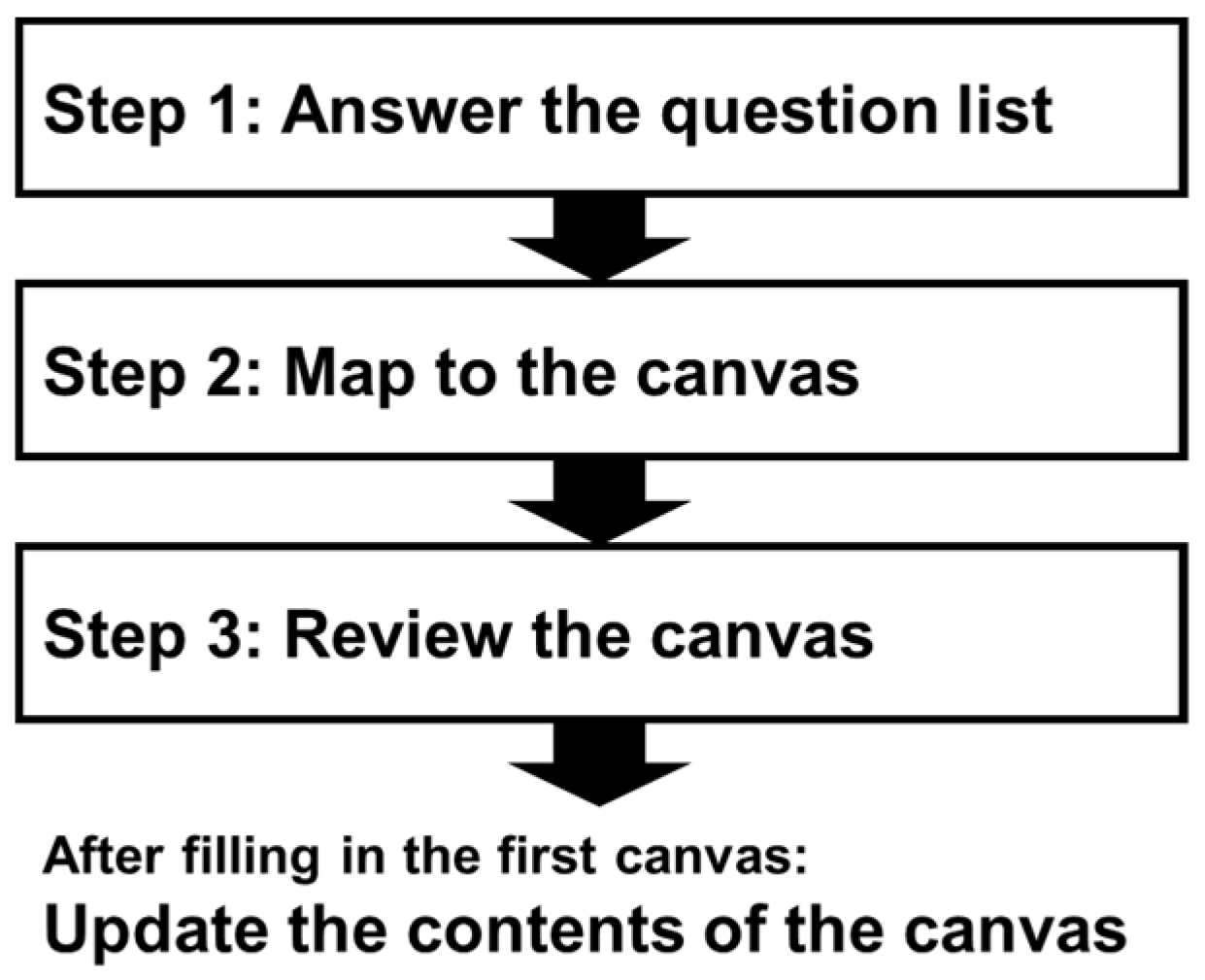
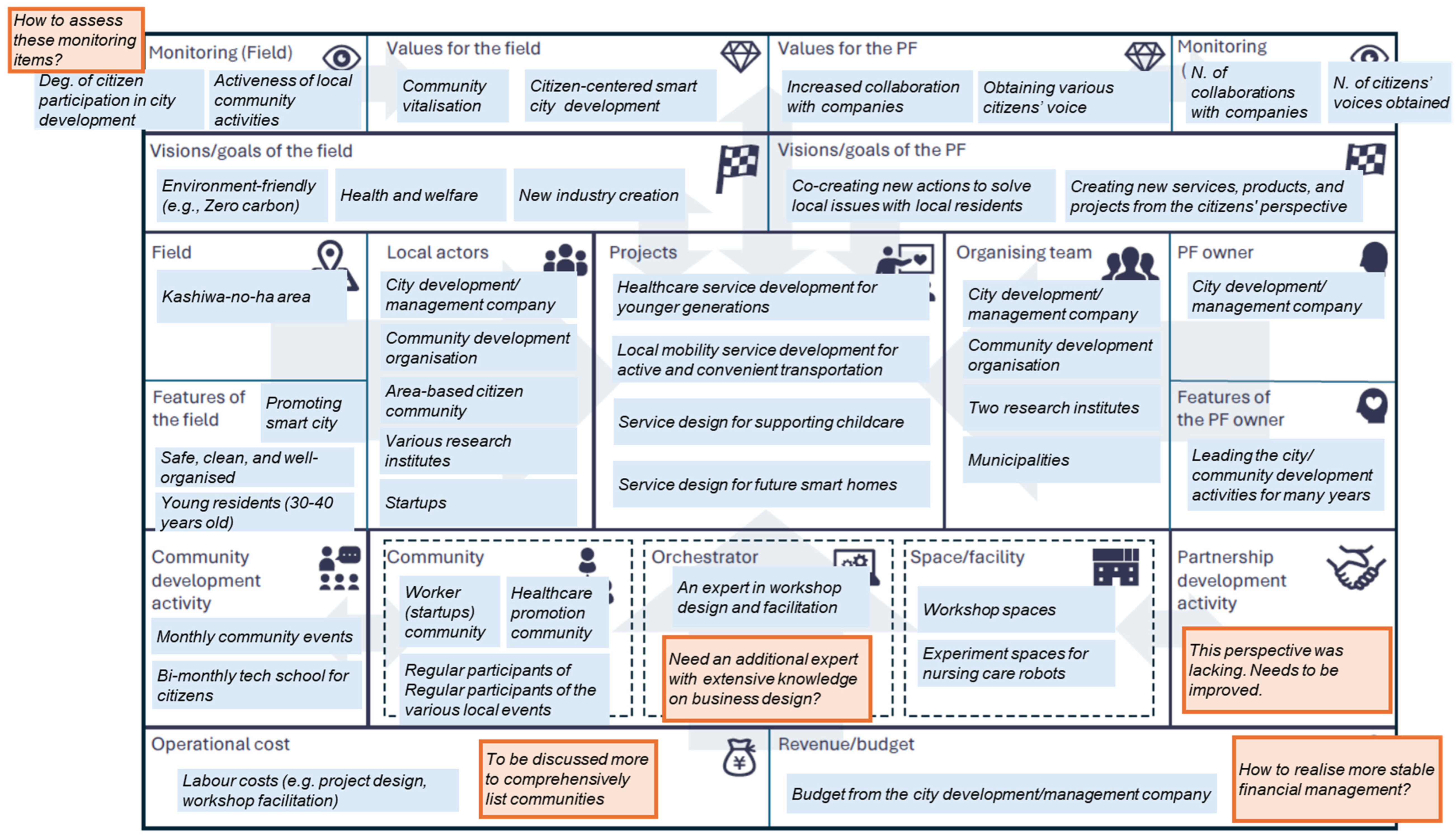
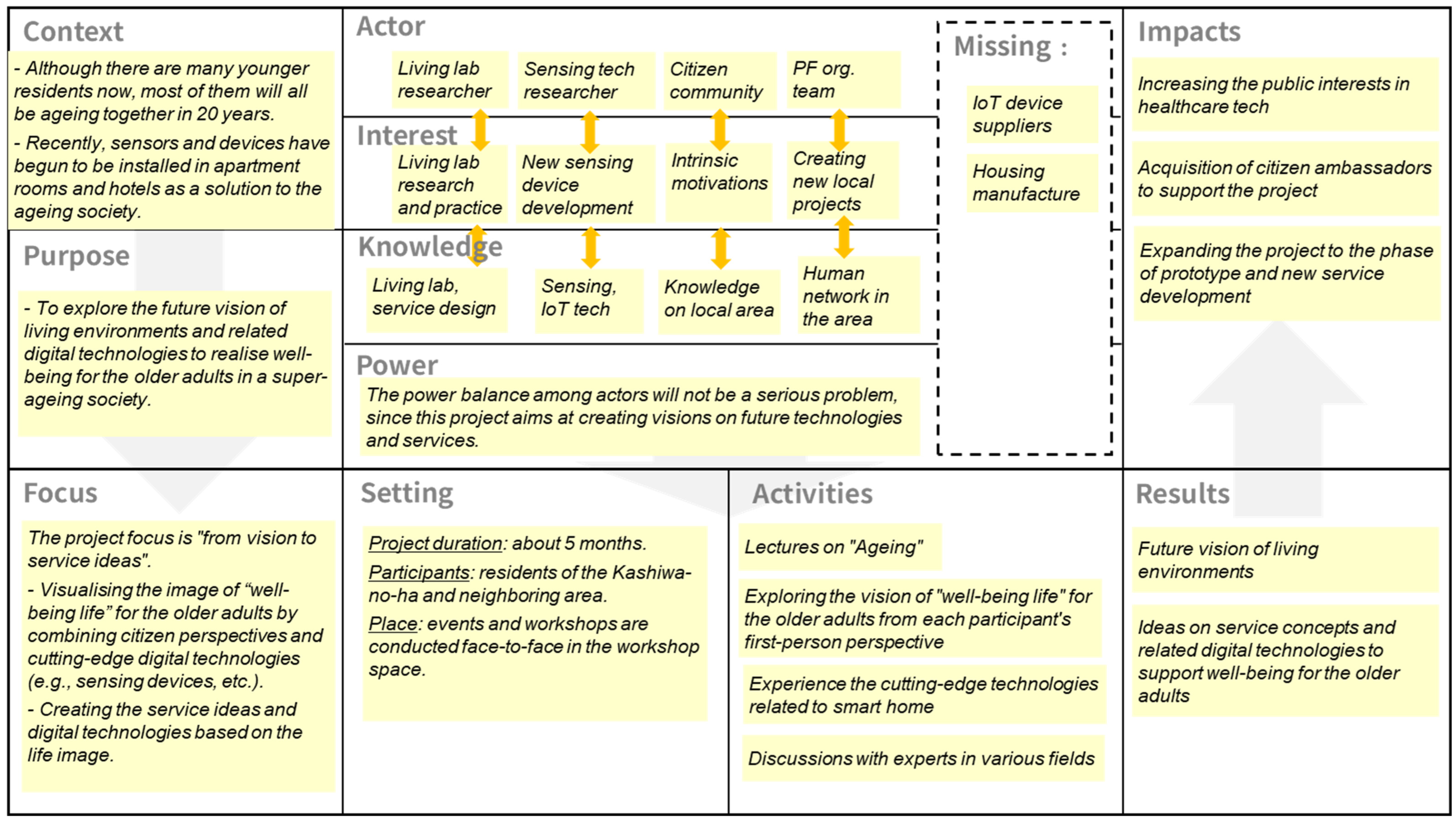
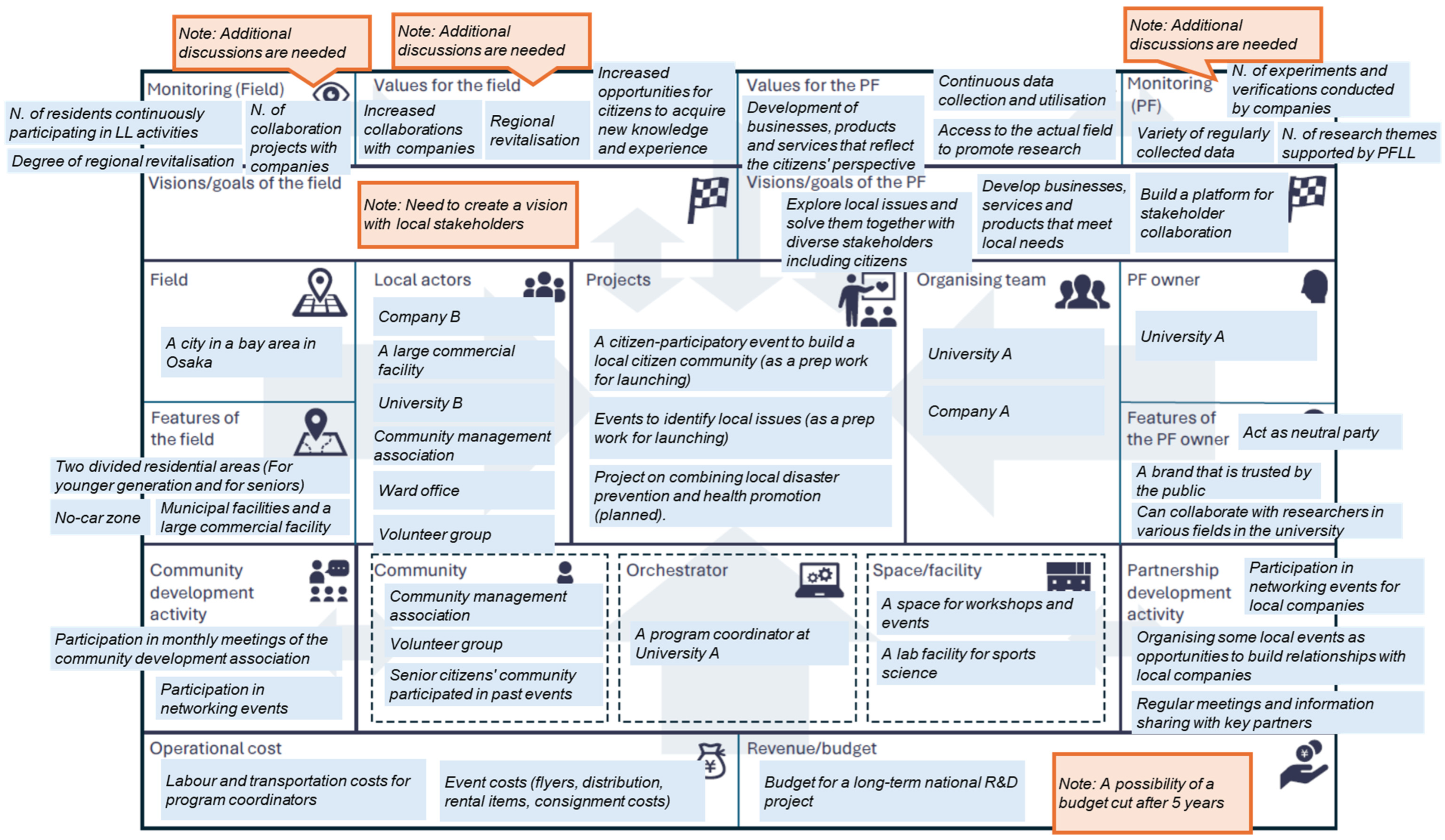
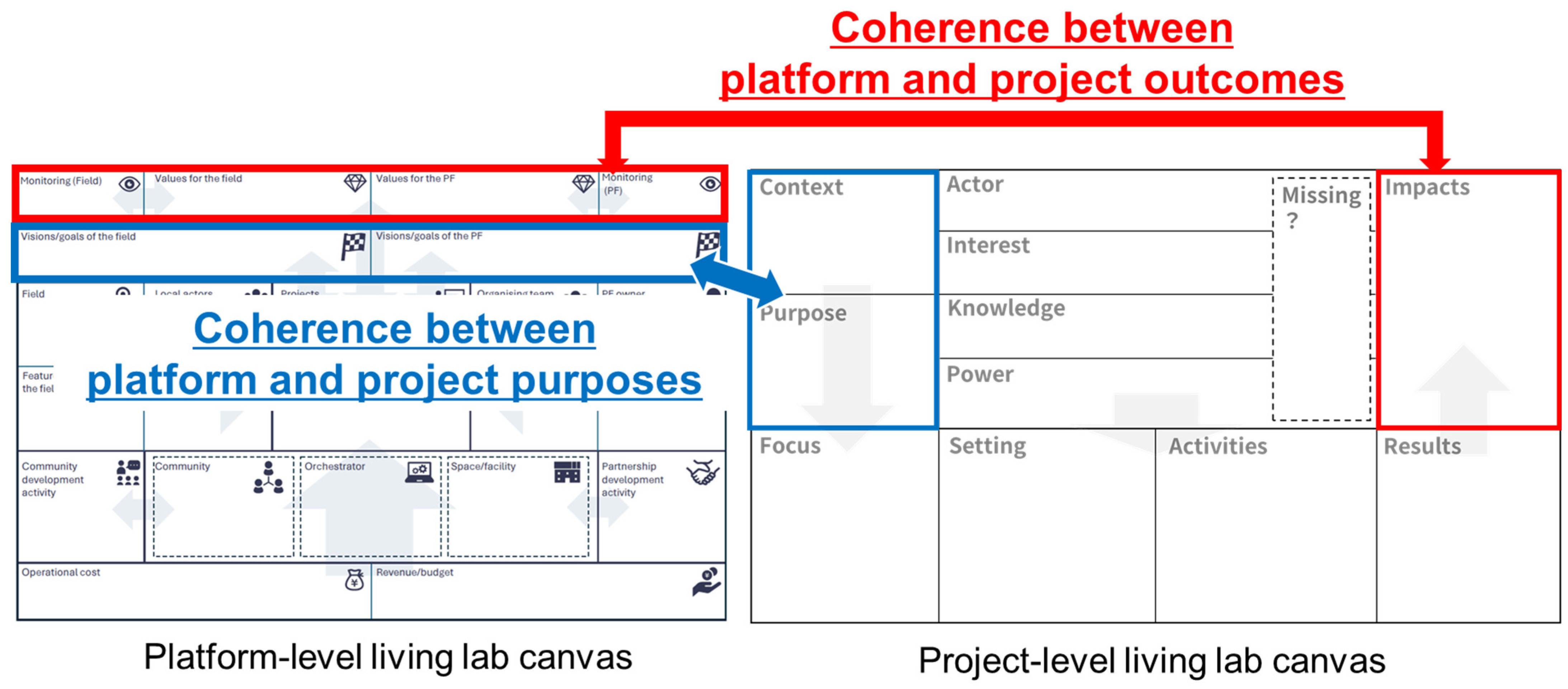
| Category | Key Elements | Descriptions | Aspects |
|---|---|---|---|
| Value | Values for the field | Values for the region/city created through the sustainable operation of the platform-level living lab. | Why |
| Values for the platform (PF) | Values or benefits for the PF organising team created through the sustainable operation of the platform-level living lab. | ||
| Vision | Visions/goals of the field | Visions or challenges to be solved in the region/city where the platform-level living lab is (or will be) set up and operated. | Why |
| Visions/goals of the PF | Visions and goals that represent what the platform organising team aims to achieve. | ||
| Field | Field | The region/city where the platform-level living lab is (or will be) set up and operated. | Where, Who |
| Features of the field | Geographical, cultural, resource, and urban features of the region/city where the platform-level living lab is (or will be) set up and operated. | ||
| Local actors | Local actors (e.g., individuals, companies, organisations, associations) who are (or potentially will be) directly or indirectly involved in a platform-level living lab. | ||
| Organising team | PF owner | The owner of the platform-level living lab. | Who |
| Features of the PF owner | Features of the platform owner (e.g., their positioning, technologies, business). | ||
| Organising team | Stakeholders (e.g., individuals, companies, organisations, associations) involved in and committed to the organising team of the platform-level living lab. | ||
| Infrastructure | Community | Local communities in the region/city as the infrastructure of the platform-level living lab. | Resources, Who, Where |
| Orchestrator | A platform-level living lab manager who facilitates collaboration between different stakeholders and acts as an orchestrator to create new values for the region/city. | ||
| Space/facility | Places (e.g., physical space, digital space, and activity base) and facilities (e.g., experimental equipment) that act as infrastructure for the platform-level living lab. | ||
| Networking | Community development activity | Activities to maintain and expand the local communities as infrastructure of the platform-level living lab. This activity corresponds to community engagement. | Resources, Who |
| Partnership development activity | Activities to maintain and expand the relationships with companies and organisations outside the region/city committed to co-creation projects (i.e., project-level living labs) prompted in the platform-level living lab. | ||
| Business model | A business model to realise the sustainable operation of the platform-level living lab. | Resources | |
| Projects | Co-creation projects that are promoted (or will be promoted or should be promoted) within the platform-level living lab. | What | |
| Question | What We Did | Case Used | Canvas Described |
|---|---|---|---|
| (1) Is the canvas tool helpful in visualising the overall structure of the platform-level living lab rather than other level-type (e.g., project-level) living labs? | Comparative study by describing two types of canvases for one ULL case | Min-sta living lab | PFLL canvas |
| Empathic Co-design Canvas | |||
| (2) Is it possible for the canvas tool to provide some insights for the better operation and management of the platform-level living lab? | Applying the PFLL canvas to another Japanese ULL case in addition to the Min-sta living lab | Min-sta living lab | PFLL canvas |
| Case B |
Disclaimer/Publisher’s Note: The statements, opinions and data contained in all publications are solely those of the individual author(s) and contributor(s) and not of MDPI and/or the editor(s). MDPI and/or the editor(s) disclaim responsibility for any injury to people or property resulting from any ideas, methods, instructions or products referred to in the content. |
© 2025 by the authors. Licensee MDPI, Basel, Switzerland. This article is an open access article distributed under the terms and conditions of the Creative Commons Attribution (CC BY) license (https://creativecommons.org/licenses/by/4.0/).
Share and Cite
Akasaka, F.; Yasuoka, M.; Nakatani, M.; Akiyama, H.; Nambu, R. Development of a Tool to Support the Sustainable Management of Urban Living Labs as Platforms for Co-Creation. Sustainability 2025, 17, 4357. https://doi.org/10.3390/su17104357
Akasaka F, Yasuoka M, Nakatani M, Akiyama H, Nambu R. Development of a Tool to Support the Sustainable Management of Urban Living Labs as Platforms for Co-Creation. Sustainability. 2025; 17(10):4357. https://doi.org/10.3390/su17104357
Chicago/Turabian StyleAkasaka, Fumiya, Mika Yasuoka, Momoko Nakatani, Hiroko Akiyama, and Ryuichi Nambu. 2025. "Development of a Tool to Support the Sustainable Management of Urban Living Labs as Platforms for Co-Creation" Sustainability 17, no. 10: 4357. https://doi.org/10.3390/su17104357
APA StyleAkasaka, F., Yasuoka, M., Nakatani, M., Akiyama, H., & Nambu, R. (2025). Development of a Tool to Support the Sustainable Management of Urban Living Labs as Platforms for Co-Creation. Sustainability, 17(10), 4357. https://doi.org/10.3390/su17104357








